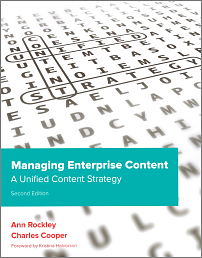Table of Contents for the second edition
1 The basis of a unified content strategy
1 Content: The lifeblood of an organization
- Content: Where does it all come from?
- Understanding the content silo trap
- What is a unified content strategy?
- Scope of a unified content strategy
- Summary
2 Intelligent content
- What is intelligent content?
- Understanding intelligent content
- Intelligent content and content strategy
- Summary
2 Where does a unified content strategy fit?
3 Enterprise content: Web and beyond
- The Web
- Mobile
- Beyond the Web
- The role of a unified content strategy
- Summary
4 Publishing
- Digital publishing, a tsunami of change
- The publishing process
- The role of a unified content strategy
- Summary
5 Product content
- The evolution of reuse in technical publications
- The role of a unified content strategy
- Summary
6 Learning materials
Types of learning materials
The role of a unified content strategy
Summary
3 Performing a substantive audit: Determining business requirements
7 What does your customer really need?
- Identifying customer needs
- Personas
- Summary
8 Where does it really hurt?
- Who to interview
- Identifying the D.O.S.® : Dangers, opportunities, and strengths
- Identifying the goals
- Identifying the challenges
- Sample questions
- Where a unified content strategy won’t help
- Summary
9 Analyzing the content lifecycle
- Identifying your content lifecycle
- Identifying the players, processes, and issues
- Summary
10 Performing a content audit
- What is a content audit?
- What’s involved in doing a content audit?
- Assessing the quality of the content
- Assessing the opportunities for content reuse
- Analyzing the content for reuse
- Content audit examples for reuse
- Summary
11 Envisioning your unified content strategy and lifecycle
- The unified content strategy
- The unified content lifecycle
- Summary
4 Developing a unified content strategy
12 Content modeling: Adaptive content design
- What is adaptive content?
- Understanding content modeling
- Content first, not mobile first, eBook first, or any other "first"
- Creating models
- Understanding granularity
- How are models used?
- How are models implemented?
- Summary
13 Reuse strategy
- Structural reuse vs. content reuse
- Creating a reuse strategy
- Reuse methods
- Securing reusable content
- Types of reuse
- Supporting adaptive design through reuse
- When doesn’t reuse make sense?
- Summary
14 Designing workflow
- What is workflow?
- Depicting workflow
- Roles, responsibilities, and processes
- Writing task descriptions
- Designing effective workflow
- Summary
15 Designing metadata
- What is metadata?
- Benefits of metadata to a unified content strategy
- Types of metadata
- Metadata relationships
- Summary
16 It’s all about the content
- Writing structured content
- Same content, different uses?
- Collaborative authoring: Breaking down the silos
- Summary
17 Change management and governance
- What is change management?
- What is governance?
- Change management
- Content governance
- Workflow governance
- Taxonomy and metadata governance
- Governance board
- Summary
5 Supporting your unified content strategy
18 Changing roles
- Senior content strategist (new role)
- Content strategist (modified role)
- Content owners (modified role)
- External authors (modified role)
- Internal authors (modified role)
- Business owners /analysts (modified role)
- Editors (modified role)
- Information architect (modified role)
- Information technologists (modified role)
- Art (modified role)
- Publishing roles
- Summary
19 The role of XML
- Should you fear XML?
- The origins
- What about DITA?
- Summary
20 The role of content management
- Authoring tools
- Content management systems
- Workflow systems
- Delivery
- Summary
6 Resources
Glossary
Bibliography
A Checklist for implementing a unified content strategy
Phase 1 – Analysis
Phase 2 – Developing a unified content strategy
Phase 3 – Selecting tools and technologies
Phase 4 – Development
Phase 5 – Testing and system modifications
Phase 6 – Pilot
Phase 7 – Implementation
Phase 8 – Post implementation
Index
|

Buy the Book
The book is available from a number of sources, and on a number of platforms.
|



